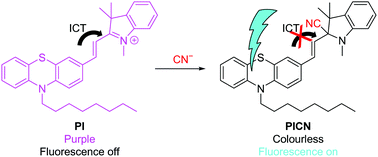A novel turn-on fluorescent sensor for cyanide ions based on the charge transfer transition of phenothiazine/indolium compounds†
Abstract
A new fluorescent sensor combining phenothiazine and indolium, which reacts specifically with cyanide ions with a large Stokes shift and a good fluorescence quantum yield, was prepared. When CN− was added to an ethanol solution containing the synthesized sensor molecules, the solution color changed from purple to colorless, and fluorescence was emitted under 270 nm light irradiation. The mechanism of this luminescence, investigated via proton nuclear magnetic resonance, electrospray ionization mass spectrometry, and computational analysis, was defined as follows: the sensor undergoes nucleophilic addition of cyanide to the carbon of C = N+ in its indolium moiety, which limits the intramolecular charge transfer, resulting in a colorless transition and blue fluorescence. The specificity of the proposed sensor for cyanide has been confirmed through tests with 14 other anions (F−, Cl−, Br−, I−, ClO3−, ClO4−, NO2−, NO3−, SO32−, SO42−, S2O32−, S2−, N3−, and SCN−) and the detection limit is 0.02 μM in the fluorescence spectrum. Changes in this sensor color can be detected by the naked eye and fluorescence emission can be induced via black light irradiation.



 Please wait while we load your content...
Please wait while we load your content...